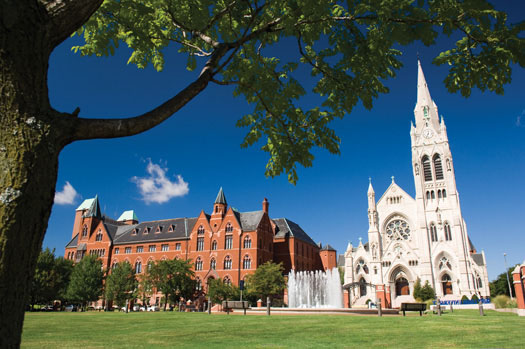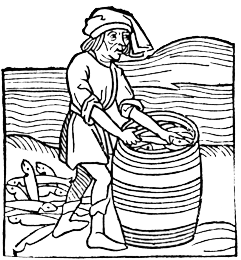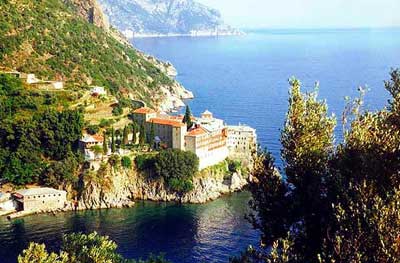This was my first time to attend the Medieval Academy of America’s Annual Meeting—my first time in Missouri, too!—and while my experience with attending large academic gatherings is not as yet very broad, I was still impressed with the friendliness of both the conference and the city. As someone who still feels very much a novice in the field, it can be quite intimidating to see around you people whose work you’ve been reading and admiring since you were an undergraduate, but all those whom I met were welcoming and informative.
The programme was full of interesting sessions. I give below a summary of those which I attended; all are based on my notes and imperfect memory, so forgive me if I omit anything important.
Thursday, March 22nd
Opening Address: “Inside/Outside: Friars and the Dynamics of Urban Space” — Caroline A. Bruzelius, Duke University.
This was a fascinating paper which used churches built by friars in medieval Italy to demonstrate that architecture is a multigenerational project, something which should be read as diachronic rather than synchronic. Professor Bruzelius showed how the externalised mission of the mendicants stretched outwards into their communities through what she termed “capillary action”—the construction of churches with external pulpits, the use of portable wooden pulpits, and the incorporation of the tombs of donors into prominent niches within the church walls. As their goals and circumstances changed, so the friars altered their surroundings, creating “additive” or pragmatic architecture. Professor Bruzelius illustrated her talk with some fascinating three-dimensional, animated models of churches—in some cases sited on scale maps of the medieval town landscape—which really captured my attention as I hope to do something similar with the results of my own dissertation research. Reading up on Professor Bruzelius’ work shows me that I will most likely be learning how to use Google Sketchup in the near future!
Session 3: Nuns and Authority — Colleen McCluskey, St Louis University. (Chair and Organiser)
The first paper in this session was given by Karen Christianson (Newberry Library) on “The Supremacy of the Abbess at Fontevraud”. Dr Christianson compared the monastic rule of Fontevraud with those of other female or dual orders, such as the Gilbertines or the Poor Clares, demonstrating not only the variety of rules adopted by female medieval monastics, but also the authority enjoyed by the Abbess at Fontevraud. She could choose to accept or reject male oblates, and she and her nuns decided on the distribution of leftovers from the monks’ table, not the monks themselves.
Richard Leson (University of Wisconsin-Milwaukee) examined the tomb effigy of Jeanne of Flanders, abbess of Le Sauvoir (“The Tomb Effigy of the Abbess Jeanne of Flanders in Laon”). While Le Sauvoir was destroyed during the French Revolution, Jeanne’s effigy was preserved in the local parish church. Professor Leson argued that her tomb effigy was more than simply a memorial to a beloved abbess, but was rather a powerful dynastic statement and a claim to authority on her part. For instance, instead of her feet resting on two lapdogs—typical of the tomb effigies of widows at this point—Jeanne’s feet rest on two lions, which bring to mind not only power in general but specifically the heraldic animal of the Flemish ruling dynasty to which Jeanne belonged. Most interestingly, Professor Leson compared Jeanne’s effigy to that of another Cistercian abbess—this one from Germany, though sadly I neglected to make note of her name—which uses similar imagery.
CARA Plenary Session: “Where Waters Meet: Medieval Culture and Modern Ecology” — Richard Hoffman, York University, Toronto.
I can safely say that I have never found the history of salmon and herring so interesting! Professor Hoffman’s lecture linked changing medieval attitudes on aquaculture to modern day concerns about conservation and ecology. Concentrating mostly on herring, salmon and stockfish populations in northwestern European rivers and the Baltic Sea, he argued that medieval people were aware of the dangers of overfishing, and of how their actions—whether building mills or dumping industrial effluent in rivers—could cause a decline in fish stocks. They worked to sustain fish stocks by issuing legislation which restricted fishing in certain places, and by encouraging innovation in aquaculture.
However, once John Cabot reached the Americas in the late fifteenth century and sent back reports of “infinite abundance, infinite fish”, the lures of easy riches and colonialism’s promise of power overrode previous incentives towards sustainability. Indeed, Hoffman suggested, we can draw a link between this shift in fishing patterns and the nineteenth and twentieth century Western environmental practices which have proven so disastrous. Definitely a paper to bring up the next time someone suggests that the Middle Ages have no contemporary relevance!
Session 17: “Competition in the Middle Ages: Reports from a Franco-American Graduate Student Network” — Adam Kosto, Columbia University; Régine LeJan, Université de Paris I Panthéon-Sorbonne (Organisers)
This session presented short papers by five French graduate students—Warren Pezé, Claire Tignolet, Arnaud Lestremeau, Adrien Bayard and Lucie Malbos—who have recently participated in a series of exchanges and joint working sessions with peers at Columbia University. The network decided on “competition” as a common theme which would inspire their own individual work, and indeed the papers covered a broad range: from editing inspired by theological controversies (Pezé) to rival Carolingian poets (Tignolet) to competing Anglo-Saxon monasteries (Lestremeau). The individual papers were very interesting, but the one thing I felt missing from the panel as a whole was the perspective of some of the American grad students taking part in the exchange. I would have loved to have learned more about the logistics of the exchange, what the students learned from the process of taking part in the exchange as much as the research that resulted from it.
Session 23: “Periculoso: Women and the Negotiation of Devotion” — Kathryne Beebe, Southeast Missouri State University (Organiser); Anne Lester, University of Colorado-Boulder (Chair)
This session was more about the psychological boundaries created by normative expectations of female Christian behaviour than it was about the eponymous papal decretal of 1298 which mandated physical enclosure for religious women; its common themes were thoroughly teased out by Dr Kathryne Beebe in her closing comment.
Karen Scott (DePaul University) spoke first on “Catherine of Siena and Lay Biblical Culture in Fourteenth-Century Italy”, examining the voluminous writings dictated by the saint for clues as to her degree of literacy, and thus to the kinds of relationship which a functionally illiterate person might have with religious texts. Professor Scott concludes that Catherine’s knowledge was a kind of “learned ignorance”—her knowledge of the bible was restricted to certain stories, most often conveyed through short sayings which could have easily been memorised, and showed no familiarity with the psalms.
Jennifer Deane (University of Minnesota-Morris) discussed “Laywomen’s Sanctification of Domestic Space in the Later Middle Ages”, a broad ranging paper which examined a variety of ways in which medieval women could use domestic devotional practices as an socially accepted means of expressing spirituality. Different kinds of household tasks, performed in different parts of the household and involving different bodily gestures, could all become forms of prayer.
Lastly, Leigh Ann Craig (Virginia Commonwealth University) delivered a lively paper entitled “The Portable Cloister: Later Medieval Nuns and the Demands of the Miraculous”. In it, she compared two houses of English nuns described in the canonisation records of Henry VI. Both houses had prayed for the late king’s intercession; both houses received their miracle. Yet one house of nuns chose to fulfil their vow to go on pilgrimage and one did not. In analysing the possible reasons why this did not happen, Professor Craig pointed to how the rigours of enclosure could be willingly embraced by medieval nuns, for a variety of reasons.
Session 30: “Digital Research in Medieval Studies” — James Ginther, St Louis University (Organiser); Jay Hammond, St Louis University (Chair)
This very well-attended session discussed some recent innovations in the digital humanities. Julian Hendrix (Carthage College) described the recent progress of the St Gall Plan Project, while Benjamin Albritton (Stanford) outlined some new thoughts about how to make digital research projects more interoperable.
I think the presentation which attracted the most attention, however, was given by James Ginther—there were audible impressed murmurs as he described T-PEN, the Transcription for Palaeographical and Editorial Notation Project. While I’m not technically minded enough to have been able to follow all the discussion of XML standards and the like, I was impressed with the capabilities this application offers. I’ve already discussed it in enthusiastic detail with my palaeography class yesterday, though I think the YouTube video linked on the T-PEN homepage sums it all up better than I could. I have high hopes for it as a means of facilitating group palaeographical projects.
Presidential Address: “Searching for Women in the Archives of Mount Athos” — Alice-Mary Talbot, Dumbarton Oaks
One of the few things I have in common with Shakespeare is that I have little Latin and less Greek, so I know far less about Byzantine history than I should. Still, I was fascinated by the world which Dr Talbot’s lecture revealed, and no less by the means through which she could document the lives of these women. Given the paucity of surviving records, one of the best caches of documents—wills, land sales, marriage contracts—is to be found in the monasteries of Mount Athos, Greece (picture right). The irony of course is that women are forbidden to set foot on the peninsula. It’s a pity there was no time left at the end for questions. I would very much like to have found out what it’s like to spend so much time working with digitised versions of manuscripts that you know you’ll never see in person.
Session 41: “The Mediterranean World in Crisis? 1300 and the Forces of Change” — Barbara Rosenwein, Loyola University (Organiser/Chair)
The answer to the question in the title of this panel seemed to be largely ‘hrm, not really.’ I’m not an economic historian and so a detailed examination of the large scale analyses employed by the speakers in this session is beyond me, but I found them all uniformly interesting and providing much fodder for thought.
Monique Bourin (Université de Paris 1-Panthéon-Sorbonne) began this session with a detailed examination of “Famines and Society”, distinguishing between instances of food shortage, dearth, and famine. Famines are usually short-lived and traumatic instances, but a dearth of food may last for a lengthy period and have consequences which are subtle but still devastating. Lluís To Figueras (University of Girona) looked at trade networks in the Western Mediterranean, pointing out that previous economic studies tend to depict medieval peasants as passive, subordinate producers of subsistence level foodstuffs. Yet, as he showed with his fascinating analysis of marriage contracts from Catalonia, they could also be active consumers whose demands created stimulus for urban crafts. John Drendel (Université du Québec à Montréal), in “The Role of the State in the Economy around 1300”, argued that the state fostered economic recovery after the Black Death by encouraging interregional trade networks, and suggested that the emergence of the notarial system within the court system ca. 1290-1350 furthered the development of trade.
Session 48: The State of Medieval Irish Studies (II) — Thomas Finan, St Louis University (Chair)
Another lively session, this one began with “The Archaeology of Later Medieval Ireland”, presented by Terry Barry (Trinity College Dublin). Professor Barry provided an overview of recent archaeological developments—particularly those which resulted from Ireland’s economic boom—which he has been compiling with a few towards writing a second edition of his Archaeology of Medieval Ireland. He also stressed the importance of archaeology for our understanding of the medieval period, though it has often been ignored by historians.
Roger Stalley (Trinity College Dublin) examined “The Gothic in Medieval Ireland”. Ireland of course doesn’t have the equivalent of a great Gothic cathedral like Chartres, but that doesn’t mean the style is absent from the island. In fact, it is spread curiously across the island, with Anglo-Norman or English bishops across the eastern half of the country likely to build or rebuild in the style, with Gaelic Irish bishops in the west tending to add some Gothic accents to already existing cathedrals—ones which were much smaller than the kinds of buildings we tend to think of when we think of cathedrals. In large part, Professor Stalley suggested, this was due to the relative poverty of each diocese, as Ireland had a proliferation of dioceses, more than were to be found in the entire island of Britain. There may also have been an element of, not an ethnicity-based aversion to a “colonial” style, but rather a desire to preserve buildings which had already acquired weighty historical associations.
With that done, and some time spent catching up with Professor Barry over coffee—we both realised that it’s been 10 years now since I started my undergraduate studies at Trinity, which horrified us both a little!—our Iowa contingent left to start the long drive back north. I think the full five and a half hours were taken up with discussions about the conference, of one kind or another, which I think qualifies it as a success.


